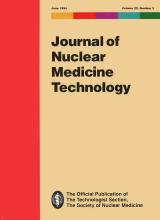Abstract
Objective: Although uncommon, accessory spleens may be visualized on the splenic images using 99mTc-sulfur colloid. Splenic trauma is relatively common in patients who have received trauma to the upper abdomen or the left lower rib cage (1). In such patients who experience severe trauma to the spleen, splenic tissue may spill into the peritoneal cavity and remain viable. This entity is called splenosis and is visualized as the viable splenic tissue retains its reticuloendothelial function (2).
Methods: We report on a female patient with prior splenic trauma and a history of breast cancer who was referred for a computed tomographic (CT) scan of the abdomen. Multiple abnormal masses were identified in the mesentery. The pathology of these masses was considered to be either splenic tissue or metastatic carcinoma.
Results: A sulfur colloid scan of the abdomen and SPECT images correlated to the CT scans confirmed reticuloendothelial function within these masses, thus splenosis.
Conclusions: Splenosis can be successfully identified using 99mTc-sulfur colloid due to the reticuloendothelial function of these tissues.







